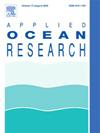Surf and swash zone hydrodynamics forced by oblique, monochromatic waves in a wave basin with a smooth, impermeable beach
IF 4.3
2区 工程技术
Q1 ENGINEERING, OCEAN
引用次数: 0
Abstract
Beaches are coastal features that offer economic benefits, ecosystem services, and natural barriers against flooding. Sustainable management of beaches requires a firm understanding of hydrodynamics and sediment transport processes. This experimental study reports on surf and swash zone hydrodynamics, forced by oblique, monochromatic waves with heights of 0.15 m, 0.20 m, and 0.25 m and periods of 2.0 s and 2.5 s, approaching a smooth impermeable beach with three different offshore incident angles (5°, 10°, 15°). Fluid velocities and bed shear stress were separated into cross-shore and alongshore directions. The data were analyzed using a triple decomposition isolating the time-averaged flow from the wave-driven flow and turbulence in each wave cycle. The velocities showed variations for different wave incident angles and cross-shore positions. The cross-shore velocities were skewed-asymmetric with steep wave fronts and velocity magnitudes reaching nearly 0.5 m/s. The cross-shore bed shear stress magnitude peaked during the start of each wave cycle reaching up to 18 N/m2. Alongshore flows remained relatively uniform during the wave cycle, with typical velocities up to 0.5 m/s. There was a non-monotonic variation of alongshore velocities with wave angle, with waves forced at 10° often exhibiting the largest alongshore velocities compared to waves forced at 15° These variations were likely due to variations in wave breaking location relative to fixed in situ sensors. Alongshore bed shear stress magnitudes peaked at the beginning of the wave cycle with values between 0.8 and 4.5 N/m2 depending on forcing conditions. The alongshore flow and bed shear stress were dominant during flow reversal when cross-shore velocities were near zero, even for small wave angles. These findings highlight the potential importance of alongshore processes on resultant bed shear stress and sediment and solute transport.
在有光滑不透水海滩的波盆中,受倾斜的单色波浪所迫的冲浪和冲刷带流体动力学
海滩是提供经济效益、生态系统服务和抵御洪水的天然屏障的海岸特征。海滩的可持续管理需要对水动力学和沉积物运输过程有坚定的理解。本实验研究报告了在高度分别为0.15 m、0.20 m和0.25 m、周期分别为2.0 s和2.5 s的单色斜波的作用下,在三种不同入射角(5°、10°、15°)接近光滑的不透水海滩时的冲浪和冲刷带流体动力学。流体速度和床层剪应力被划分为海岸方向和海岸方向。数据的分析采用了三重分解,将时间平均流与每个波周期的波浪驱动流和湍流分离开来。在不同的入射角和跨岸位置上,速度表现出不同的变化。跨岸速度呈偏不对称,波前陡峭,速度震级接近0.5 m/s。各波周期开始时,跨海岸剪切应力强度达到峰值,最高可达18 N/m2。在波浪周期中,沿岸流动保持相对均匀,典型速度可达0.5米/秒。沿岸速度随波角呈非单调变化,与15°波浪相比,10°波浪往往显示出最大的沿岸速度,这些变化可能是由于相对于固定原位传感器的波浪破碎位置的变化。在波浪周期开始时,岸床剪切应力值达到峰值,根据强迫条件的不同,剪应力值在0.8 ~ 4.5 N/m2之间。当跨岸速度接近于零时,即使波浪角很小,回流过程中沿岸流和河床剪应力也占主导地位。这些发现强调了岸岸过程对由此产生的河床剪切应力、沉积物和溶质运移的潜在重要性。
本文章由计算机程序翻译,如有差异,请以英文原文为准。
求助全文
约1分钟内获得全文
求助全文
来源期刊

Applied Ocean Research
地学-工程:大洋
CiteScore
8.70
自引率
7.00%
发文量
316
审稿时长
59 days
期刊介绍:
The aim of Applied Ocean Research is to encourage the submission of papers that advance the state of knowledge in a range of topics relevant to ocean engineering.
 求助内容:
求助内容: 应助结果提醒方式:
应助结果提醒方式:


